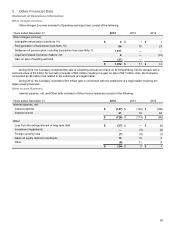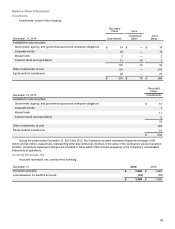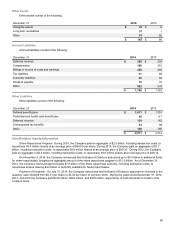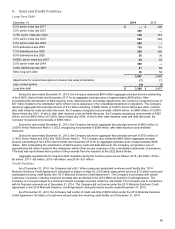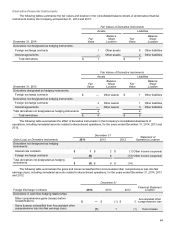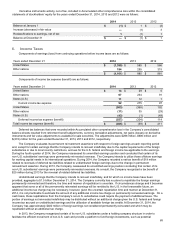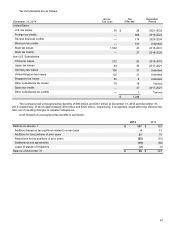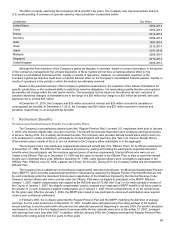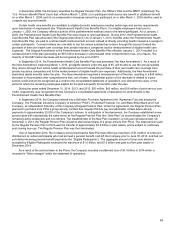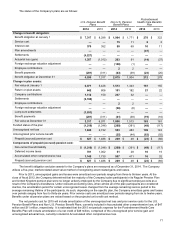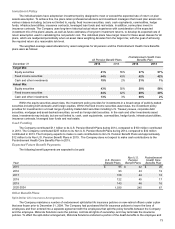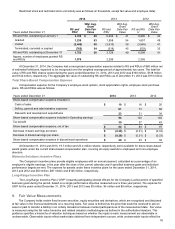Motorola 2014 Annual Report Download - page 68
Download and view the complete annual report
Please find page 68 of the 2014 Motorola annual report below. You can navigate through the pages in the report by either clicking on the pages listed below, or by using the keyword search tool below to find specific information within the annual report.
66
acquisitions and capital expenditures. During 2013, the Company recognized a $337 million tax benefit associated with the
excess tax credits relating to the earnings of certain non-U.S. subsidiaries reorganized under the holding company structure.
Differences between income tax expense (benefit) computed at the U.S. federal statutory tax rate of 35% and income tax
expense (benefit) as reflected in the consolidated statements of operations are as follows:
Years ended December 31 2014 2013 2012
Income tax expense at statutory rate $ (406) $ 308 $ 308
Tax on non-U.S. earnings (27) 17 (10)
State income taxes, net of federal benefit (30) 8 (32)
Recognition of previously unrecognized income tax benefits (29) 6 —
Other provisions 9(4) (10)
Valuation allowances 55 (3) (60)
Section 199 deduction (12) (14) (14)
Tax on undistributed non-U.S. earnings (19) (22) 29
Research credits (6) (18) —
Tax benefit of repatriated non-U.S. earnings —(337) —
$ (465) $ (59) $ 211
Gross deferred tax assets were $3.6 billion and $3.7 billion at December 31, 2014 and 2013, respectively. Deferred tax
assets, net of valuation allowances, were $3.4 billion and $3.5 billion at December 31, 2014 and 2013, respectively. Gross
deferred tax liabilities were $774 million and $1.1 billion at December 31, 2014 and 2013, respectively.
Significant components of deferred tax assets (liabilities) are as follows:
December 31 2014 2013
Inventory $ 34 $ 46
Accrued liabilities and allowances 148 129
Employee benefits 799 814
Capitalized items 379 144
Tax basis differences on investments (10) 17
Depreciation tax basis differences on fixed assets 52 12
Undistributed non-U.S. earnings (18) (6)
Tax carryforwards 1,246 1,294
Business reorganization 22 39
Warranty and customer liabilities 19 19
Deferred revenue and costs 136 159
Valuation allowances (226) (200)
Deferred charges 39 38
Other (38) (64)
$ 2,582 $ 2,441
At December 31, 2014 and 2013, the Company had valuation allowances of $226 million and $200 million, respectively,
against its deferred tax assets, including $195 million and $178 million, respectively, relating to deferred tax assets for non-U.S.
subsidiaries. The Company’s valuation allowances for its non-U.S. subsidiaries had a net increase of $17 million during 2014
and a net decrease of $56 million during 2013. The increase in the valuation allowance relating to deferred tax assets of non-
U.S. subsidiaries during 2014 relates to deferred tax assets that are not more-likely-than-not to be realizable based on estimates
of future taxable income. The decrease in the valuation allowance relating to deferred tax assets of non-U.S. subsidiaries during
2013 reflects current year deferred tax movements, expiration of loss carryforwards and exchange rate variances.
The Company’s U.S. valuation allowance had a net increase of $9 million during 2014 and a net decrease of $4 million
during 2013. The U.S. valuation allowance of $31 million as of December 31, 2014 primarily relates to state tax carryforwards.
The Company believes that the remaining deferred tax assets are more-likely-than-not to be realizable based on estimates of
future taxable income and the implementation of tax planning strategies.


